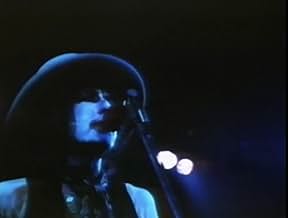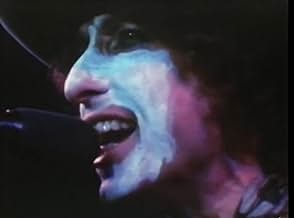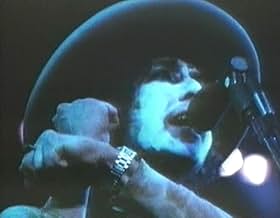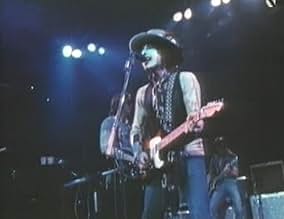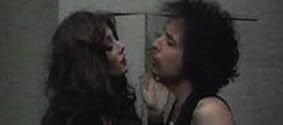NOTE IMDb
6,6/10
635
MA NOTE
Ajouter une intrigue dans votre langueBob Dylan on tour with the Rolling Thunder Revue in 1975; concert footage, documentary interviews and bizarre improvised character scenes.Bob Dylan on tour with the Rolling Thunder Revue in 1975; concert footage, documentary interviews and bizarre improvised character scenes.Bob Dylan on tour with the Rolling Thunder Revue in 1975; concert footage, documentary interviews and bizarre improvised character scenes.
- Réalisation
- Scénario
- Casting principal
- Récompenses
- 2 victoires au total
Ramblin' Jack Elliott
- Longheno de Castro
- (as Jack Elliott)
Ruth Tyrangel
- The Girlfriend
- (as Ruth Tyrangiel)
J. Stephen Soles
- Ramon
- (as Steven Soles)
Avis à la une
These days most everything is inherently cinematic: poetry, music, literature.
That's a good thing if you understand how cinema works and can escape its control when needed. One technique is to retreat to non-cinematic art, to surf the various pathways therein and then come back to the moving image from the outside.
This film, if you can find the five hour version, can provide one such exercise. Dylan builds his songs around images, but they are not images from film or film-influenced phrases. His images are what appears in dreams, originating in real life and sliced and diced by drugs. (Incidentally, the period of this film marks the transition from active tripping of various kinds to passive by his "acceptance" of fundamentalism another drug.)
His method has always been to eschew a plan, to avoid premeditated structure, to abandon great themes. Instead, he just starts, waits for images and ideas to appear and then arranges them on the table. His art is a combination of selection and composition. The selection is a matter of discarding everything that seems to be simple. That automatically puts him in the world of the Tambourine Man, where he has been in various guises for decades.
The matter of composition is something else. He just trusts how they appear. Since they all come from one mind, and that mind is coherent and somewhat interesting, they hang together. He doesn't know how they do and has given up questioning, except for a brief period of examining Kabbalah.
That's how he does it with his music, and it works to judge from his audience. He also does it with his prose rambles. This works less well; the act of juxtaposing elements in his songs leverages the vocabulary of rhythmic associations he pretty much invented. But he has no equivalent to serve his writing projects, so most of them come across as sophomoric. Same with this film.
He just started. But images in film (at least films like this) have to come from things that are presented in the real world. He relies on some friends to help create and select the images/ scenes/sequences. Ginsberg is an anchor who does understand the rhythms of poetry where Bob does not, but he is as ignorant as Bob concerning film.
Another friend is Sam Shepard who is credited as co-writer. During this time, he was working with Terence Malick on another project which is about the same problem of selection. Shepard and Malick for that matter have a coherent theory of "selection" that they can use in conceiving their projects and setting the basic tone. We can see much of that here; it all relates to folding of persons into characters that are assignable to other bodies. Thus we have many "actors" playing more than one role; roles that are assigned to more than one actor; scenes that are copied from real life; lives that are generated from scenes (bordello vignettes, Indian cosmologies, Black injustices, beat poems...)
That's the selection half and it is interesting as all getout. The composition half is pure dreck. Dylan trusts his intuitions as he always does. But these pieces don't all come from the inner spinning of a whole mind like Kieslowski's or Tarkovsky's. They come from all over and he stitches them together as if they did actually come from his visions. But they didn't so it has no coherent being.
He tries to use songs, his and others, as glue. Some of these are enjoyable by themselves but they sure don't help assemble a cinematic being.
Ted's Evaluation -- 2 of 3: Has some interesting elements.
That's a good thing if you understand how cinema works and can escape its control when needed. One technique is to retreat to non-cinematic art, to surf the various pathways therein and then come back to the moving image from the outside.
This film, if you can find the five hour version, can provide one such exercise. Dylan builds his songs around images, but they are not images from film or film-influenced phrases. His images are what appears in dreams, originating in real life and sliced and diced by drugs. (Incidentally, the period of this film marks the transition from active tripping of various kinds to passive by his "acceptance" of fundamentalism another drug.)
His method has always been to eschew a plan, to avoid premeditated structure, to abandon great themes. Instead, he just starts, waits for images and ideas to appear and then arranges them on the table. His art is a combination of selection and composition. The selection is a matter of discarding everything that seems to be simple. That automatically puts him in the world of the Tambourine Man, where he has been in various guises for decades.
The matter of composition is something else. He just trusts how they appear. Since they all come from one mind, and that mind is coherent and somewhat interesting, they hang together. He doesn't know how they do and has given up questioning, except for a brief period of examining Kabbalah.
That's how he does it with his music, and it works to judge from his audience. He also does it with his prose rambles. This works less well; the act of juxtaposing elements in his songs leverages the vocabulary of rhythmic associations he pretty much invented. But he has no equivalent to serve his writing projects, so most of them come across as sophomoric. Same with this film.
He just started. But images in film (at least films like this) have to come from things that are presented in the real world. He relies on some friends to help create and select the images/ scenes/sequences. Ginsberg is an anchor who does understand the rhythms of poetry where Bob does not, but he is as ignorant as Bob concerning film.
Another friend is Sam Shepard who is credited as co-writer. During this time, he was working with Terence Malick on another project which is about the same problem of selection. Shepard and Malick for that matter have a coherent theory of "selection" that they can use in conceiving their projects and setting the basic tone. We can see much of that here; it all relates to folding of persons into characters that are assignable to other bodies. Thus we have many "actors" playing more than one role; roles that are assigned to more than one actor; scenes that are copied from real life; lives that are generated from scenes (bordello vignettes, Indian cosmologies, Black injustices, beat poems...)
That's the selection half and it is interesting as all getout. The composition half is pure dreck. Dylan trusts his intuitions as he always does. But these pieces don't all come from the inner spinning of a whole mind like Kieslowski's or Tarkovsky's. They come from all over and he stitches them together as if they did actually come from his visions. But they didn't so it has no coherent being.
He tries to use songs, his and others, as glue. Some of these are enjoyable by themselves but they sure don't help assemble a cinematic being.
Ted's Evaluation -- 2 of 3: Has some interesting elements.
When it was theatrically released in most of Europa,BOb Dylan's work was boiled down to a 100 min version.I had to wait almost thirty years to see the complete movie (about 4 hours).Was it worth the wait?
The performances make me inclined to think that it was.Virtually all the songs Dylan performs are great live moments,and it would be wise to release (I think it has already been done)an only-songs DVD:Wearing a mask,or with his white make-up,Dylan's sings his songs as if "a life were depending on them " (and in the case of "Hurricane" it is true!):all the songs from the "desire" album are superior to the studio tracks:"Isis", "one more cup of coffee" and "romance in Durango" are almost spooky.The "blood on the tracks" material triumphs too: "tangled up is blue " will blow your mind and a strange "if you see her say hello" accompanied on piano which is heard when Dylan and Baez walk across the snow is so "new" I did not recognize the song at first."A hard rain 's gonna fall becomes a heavy metal stomp which makes the original 1963 version sound like a demo.There's also a countrified "I want you" (not as stunning,perhaps ,as the slow Budokan version),a moving "Sarah" (Lowndes)and a rare live version (heard as background)of "Sad Eyed Lady of the Lowlands " .
We are also treated to the delights of the duets.I'm not the kind of people to tell you that Baez "is holding Bob back and makes him a robot on a leash":when they sing together ,I'm on cloud nine Johnny Ace's "never let me go" is brilliant and a very long version of "the water is wide" is heard during one of the numerous scenes of the Renaldo/Clara/Woman in White triangle.
Baez's "Diamonds and rust" is admirable but unfortunately it is cut ,which is a shame!Roger McGuinn gives a riveting instrumental version of his Byrds classic "Eight Miles High" with Baez's doing the frug to it and then leads the band into a blistering version of "Chesnut mare" another Byrds classic.
I would not go as far as to write that the non-musical sequences were as magical as the others.David Blue playing pinball and remembering the Village days is not really absorbing (although he mentions Phil Ochs -who could have been part of the Rolling Thunder Review);the love triangle deals with the three involved persons's private lives and I do not think it will interest the younger generation who almost knows nothing about their love affairs;outside of the handful of artists I've mentioned,the other musical sequences are average-to-poor.
One can save the scenes on the street concerning Rubin Carter and the one when Ginsberg and Dylan visit Jack Kerouac's grave .Even more disturbing is this other sequence in a graveyard where the two men speak of Jesus and the Way of the Cross.This and "people get ready " ("there's no room for the hopeless sinner") might explain Dylan's sudden (and short-lived) conversion to Christianity in the late seventies.
"Renaldo and Clara" is a hotchpotch ;it's hard to imagine a non Dylan buff sitting through these four hours.
Like this? Try this: "Hard Rain" a 1976 concert:they wrote that the Rolling Thunder Review was moribund at the time but don't you believe them!"Hard rain" is one -hour long and there is never a dull moment !(most of the material was released on the eponymous album)
The performances make me inclined to think that it was.Virtually all the songs Dylan performs are great live moments,and it would be wise to release (I think it has already been done)an only-songs DVD:Wearing a mask,or with his white make-up,Dylan's sings his songs as if "a life were depending on them " (and in the case of "Hurricane" it is true!):all the songs from the "desire" album are superior to the studio tracks:"Isis", "one more cup of coffee" and "romance in Durango" are almost spooky.The "blood on the tracks" material triumphs too: "tangled up is blue " will blow your mind and a strange "if you see her say hello" accompanied on piano which is heard when Dylan and Baez walk across the snow is so "new" I did not recognize the song at first."A hard rain 's gonna fall becomes a heavy metal stomp which makes the original 1963 version sound like a demo.There's also a countrified "I want you" (not as stunning,perhaps ,as the slow Budokan version),a moving "Sarah" (Lowndes)and a rare live version (heard as background)of "Sad Eyed Lady of the Lowlands " .
We are also treated to the delights of the duets.I'm not the kind of people to tell you that Baez "is holding Bob back and makes him a robot on a leash":when they sing together ,I'm on cloud nine Johnny Ace's "never let me go" is brilliant and a very long version of "the water is wide" is heard during one of the numerous scenes of the Renaldo/Clara/Woman in White triangle.
Baez's "Diamonds and rust" is admirable but unfortunately it is cut ,which is a shame!Roger McGuinn gives a riveting instrumental version of his Byrds classic "Eight Miles High" with Baez's doing the frug to it and then leads the band into a blistering version of "Chesnut mare" another Byrds classic.
I would not go as far as to write that the non-musical sequences were as magical as the others.David Blue playing pinball and remembering the Village days is not really absorbing (although he mentions Phil Ochs -who could have been part of the Rolling Thunder Review);the love triangle deals with the three involved persons's private lives and I do not think it will interest the younger generation who almost knows nothing about their love affairs;outside of the handful of artists I've mentioned,the other musical sequences are average-to-poor.
One can save the scenes on the street concerning Rubin Carter and the one when Ginsberg and Dylan visit Jack Kerouac's grave .Even more disturbing is this other sequence in a graveyard where the two men speak of Jesus and the Way of the Cross.This and "people get ready " ("there's no room for the hopeless sinner") might explain Dylan's sudden (and short-lived) conversion to Christianity in the late seventies.
"Renaldo and Clara" is a hotchpotch ;it's hard to imagine a non Dylan buff sitting through these four hours.
Like this? Try this: "Hard Rain" a 1976 concert:they wrote that the Rolling Thunder Review was moribund at the time but don't you believe them!"Hard rain" is one -hour long and there is never a dull moment !(most of the material was released on the eponymous album)
The movie was filled with bad acting.
Plus, this movie did Joan Baez extremely dirty, erasing the fact that Joan Baez dated Bob Dylan in 1964. In 1965 Bob Dylan cheated on Joan Baez with Sara Lownds, then he goes & re-write history in Renaldo and Clara, turning Joan into the 'other woman' in his fairy tale marriage.
Warning: At the timestamp of 3 hours 20 minutes, Bob Dylan starts gargling. What is this? A Cofsils experdine gargle commercial?
Alternate title of the movie: This Movie is a Giant Middle Finger to Joan Baez. Dump Joan Baez, break her heart, marry the other girl named Sara Lownds, and then flip the tables and cast Joan Baez as the other girl instead. Talk about erasing the truth, eh? Plus, gargle a while to make audience confused and make people fools for 4 hours straight and pretend it to be a cinematic masterpiece".
Plus, this movie did Joan Baez extremely dirty, erasing the fact that Joan Baez dated Bob Dylan in 1964. In 1965 Bob Dylan cheated on Joan Baez with Sara Lownds, then he goes & re-write history in Renaldo and Clara, turning Joan into the 'other woman' in his fairy tale marriage.
Warning: At the timestamp of 3 hours 20 minutes, Bob Dylan starts gargling. What is this? A Cofsils experdine gargle commercial?
Alternate title of the movie: This Movie is a Giant Middle Finger to Joan Baez. Dump Joan Baez, break her heart, marry the other girl named Sara Lownds, and then flip the tables and cast Joan Baez as the other girl instead. Talk about erasing the truth, eh? Plus, gargle a while to make audience confused and make people fools for 4 hours straight and pretend it to be a cinematic masterpiece".
Quirky, idiosyncratic, often confusing and much too long mixture of concert footage, documentary and fictional scenes is definitely fascinating to watch, but one wonders, if Bob Dylan ever was certain about his intentions to create this film or whether he had an idea who its potential audience would be.
Renaldo and Clara (1978) 235 min., Theatrical cut
* 1/2 (out of 4)
Bob Dylan plays Renaldo, his real life wife Sara plays Clara and Joan Baez, Dylan's long-time mistress, plays The Woman in White. This 1978 film features Dylan as director and it hit theaters with a huge bomb as critics tore it apart, fans didn't show up to see it and some theater owners refused to play it. Dylan later edited the film down to 122-minutes, which featured mostly concert stuff, but this version hasn't been seen since the original release. All of this was filmed during Dylan's 1975 Rolling Thunder Revue, which in my opinion featured Dylan's at his best and only ranking second behind the legendary 1966 tour. The gimmick of this tour was that Dylan, along with Baez, Jack Elliott, Bob Neuwirth and various others would tour around the country without announcing any dates. Instead, they'd simply have their tour bus stop and the concert would take place within the matter of days, if not on that day itself.
As far as a story goes, it's all over the place. We have the central story of Renaldo and Clara and the husband's affair with The Lady in White, which is clearly drawn off Dylan's own marital issues. We also have Ronnie Hawkins playing Bob Dylan with Ronne Blakley playing his wife with these segments centering on the price of being a legend. We also have other wide range of events with coverage of Rubin "Hurricane" Carter taking some of the running time, which this tour, with Dylan's song "Hurricane", was trying to bring awareness to his case.
I'm a die-hard Dylan fan but the first hour of this film is among the worst stuff ever put to film. The movie is downright self indulgent, self centered and very poorly directed. However, with that said, something happens during the later part of the film, which for about an hour, makes it somewhat entertaining. It's really hard to absolutely trash this film because the concert footage is very special and feature some great tracks. Dylan, appearing in whiteface, does some of his greatest stuff on this tour and that features the greatest versions of "It Ain't Me Babe" and "A Hard Rain's A-Gonna Fall". Both of these classic folk tunes are given the "rock-a-billy" treatment and I've yet to hear better versions. Dylan also plays more recent turns including a blazing version of "Iris", a heartbreaking version of "Sara" and the opening number "When I Paint My Masterpiece". You also have a very heartfelt and deeply emotional performance of "Just Like a Woman" and a great country version of "I Want You". Dylan fans will also be interested in a brief clip of "Sad Eyed Lady of the Lowlands", which is the only known performance of this song, although it can only be heard briefly in the background. We also get a cover of "House of the Rising Sun" and duets with Baez on "Blowin' in the Wind" and "I Shall Be Released".
Even with the great music, for the most part this film is a total washout as we're watching home movies for nearly four hours. There's no camera-work to speak of as the camera is simply all over the place and there's never any clear focus or shots set up. It appears everything was done with one take and the ugliness of the picture really comes through. However, I will add, that I've never seen a film like this so perhaps that's another positive for the film. There are countless scenes that come out of no where and really mean nothing including a very long sequence with Indians fighting over equal rights. We also get countless scenes of David Blue talking about the old days of the Village where Dylan and various others got their start. There are some interesting insights here but the footage just keeps going and going to the point where it gets boring. There's also footage with Rubin "Hurricane" Carter that is pretty interesting as we see him in jail, although none of the concert footage of Dylan performing at the prison is included (only news footage is currently available via bootlegs). There's some other nice stuff including the stage being set up, Dylan before and after shows as well as other sequences where we get to see Dylan being Dylan but I doubt anyone, outside of major fans, are going to sit through four hours of stuff just for these magical moments.
In the end, this film is a total disaster that only die-hard fans will enjoy. In fact, I'd bet most people couldn't get past the one hour mark with this thing, which is the reason this thing didn't stay in theaters over a week. The movie has been pulled by Dylan, which means the only way to see it are through bootlegs but who knows if Dylan will ever let the movie be released again. I'd certainly love to hear from him and what the film was trying to do but the closest we've come to this is an interview where Dylan said people should be stoned when they watch it. Sadly, I didn't have any reefer handy when i viewed the film so I can't comment on how true that statement is. Again, this is a very special period in Dylan's career but this documentary/film doesn't touch upon its greatness. The Rolling Thunder Revue would run into early 1976 before ticket sales turned bad and the West Coast tour was canceled all together. Thankfully Columbia released "Live 1975" as part of their Genuine Bootleg Series, which is highly recommended. Also available is the original live CD "Hard Rain", which also produced a TV show and an alternate version, which hasn't been released outside of bootlegs.
* 1/2 (out of 4)
Bob Dylan plays Renaldo, his real life wife Sara plays Clara and Joan Baez, Dylan's long-time mistress, plays The Woman in White. This 1978 film features Dylan as director and it hit theaters with a huge bomb as critics tore it apart, fans didn't show up to see it and some theater owners refused to play it. Dylan later edited the film down to 122-minutes, which featured mostly concert stuff, but this version hasn't been seen since the original release. All of this was filmed during Dylan's 1975 Rolling Thunder Revue, which in my opinion featured Dylan's at his best and only ranking second behind the legendary 1966 tour. The gimmick of this tour was that Dylan, along with Baez, Jack Elliott, Bob Neuwirth and various others would tour around the country without announcing any dates. Instead, they'd simply have their tour bus stop and the concert would take place within the matter of days, if not on that day itself.
As far as a story goes, it's all over the place. We have the central story of Renaldo and Clara and the husband's affair with The Lady in White, which is clearly drawn off Dylan's own marital issues. We also have Ronnie Hawkins playing Bob Dylan with Ronne Blakley playing his wife with these segments centering on the price of being a legend. We also have other wide range of events with coverage of Rubin "Hurricane" Carter taking some of the running time, which this tour, with Dylan's song "Hurricane", was trying to bring awareness to his case.
I'm a die-hard Dylan fan but the first hour of this film is among the worst stuff ever put to film. The movie is downright self indulgent, self centered and very poorly directed. However, with that said, something happens during the later part of the film, which for about an hour, makes it somewhat entertaining. It's really hard to absolutely trash this film because the concert footage is very special and feature some great tracks. Dylan, appearing in whiteface, does some of his greatest stuff on this tour and that features the greatest versions of "It Ain't Me Babe" and "A Hard Rain's A-Gonna Fall". Both of these classic folk tunes are given the "rock-a-billy" treatment and I've yet to hear better versions. Dylan also plays more recent turns including a blazing version of "Iris", a heartbreaking version of "Sara" and the opening number "When I Paint My Masterpiece". You also have a very heartfelt and deeply emotional performance of "Just Like a Woman" and a great country version of "I Want You". Dylan fans will also be interested in a brief clip of "Sad Eyed Lady of the Lowlands", which is the only known performance of this song, although it can only be heard briefly in the background. We also get a cover of "House of the Rising Sun" and duets with Baez on "Blowin' in the Wind" and "I Shall Be Released".
Even with the great music, for the most part this film is a total washout as we're watching home movies for nearly four hours. There's no camera-work to speak of as the camera is simply all over the place and there's never any clear focus or shots set up. It appears everything was done with one take and the ugliness of the picture really comes through. However, I will add, that I've never seen a film like this so perhaps that's another positive for the film. There are countless scenes that come out of no where and really mean nothing including a very long sequence with Indians fighting over equal rights. We also get countless scenes of David Blue talking about the old days of the Village where Dylan and various others got their start. There are some interesting insights here but the footage just keeps going and going to the point where it gets boring. There's also footage with Rubin "Hurricane" Carter that is pretty interesting as we see him in jail, although none of the concert footage of Dylan performing at the prison is included (only news footage is currently available via bootlegs). There's some other nice stuff including the stage being set up, Dylan before and after shows as well as other sequences where we get to see Dylan being Dylan but I doubt anyone, outside of major fans, are going to sit through four hours of stuff just for these magical moments.
In the end, this film is a total disaster that only die-hard fans will enjoy. In fact, I'd bet most people couldn't get past the one hour mark with this thing, which is the reason this thing didn't stay in theaters over a week. The movie has been pulled by Dylan, which means the only way to see it are through bootlegs but who knows if Dylan will ever let the movie be released again. I'd certainly love to hear from him and what the film was trying to do but the closest we've come to this is an interview where Dylan said people should be stoned when they watch it. Sadly, I didn't have any reefer handy when i viewed the film so I can't comment on how true that statement is. Again, this is a very special period in Dylan's career but this documentary/film doesn't touch upon its greatness. The Rolling Thunder Revue would run into early 1976 before ticket sales turned bad and the West Coast tour was canceled all together. Thankfully Columbia released "Live 1975" as part of their Genuine Bootleg Series, which is highly recommended. Also available is the original live CD "Hard Rain", which also produced a TV show and an alternate version, which hasn't been released outside of bootlegs.
Le saviez-vous
- AnecdotesThe film got many negative reviews, and some theaters refused to show it. Most theaters showed a two-hour cut that was mostly concert footage. The original four-hour director's cut was first shown on European television years later.
- Citations
The Truck Driver: Why are you so much in a hurry? Is the law after you?
Renaldo: I am the law!
- Crédits fousThe opening credits end with a title card reading "A Film by BOB DYLAN" directed after he is credited as writer and director. The closing credits are divided in three sections, separated by wide time gaps, played over a different artist, soul singer Hal Frazier, performing "In The Morning", a song written by Barry Gibb.
- Versions alternativesOriginally released at 292 minutes (yes, that's almost five hours!). After dismal box office returns, Dylan shortened the film to 122 minutes removing almost all of the narrative storyline and leaving mostly concert footage.
- ConnexionsFeatured in Bob Dylan: Change on the Tracks (2008)
- Bandes originalesWhen I Paint My Masterpiece
Written and performed by Bob Dylan
Meilleurs choix
Connectez-vous pour évaluer et suivre la liste de favoris afin de recevoir des recommandations personnalisées
- How long is Renaldo and Clara?Alimenté par Alexa
Détails
- Durée3 heures 55 minutes
- Mixage
- Rapport de forme
- 1.85 : 1
Contribuer à cette page
Suggérer une modification ou ajouter du contenu manquant

Lacune principale
By what name was Renaldo et Clara (1978) officially released in India in English?
Répondre
